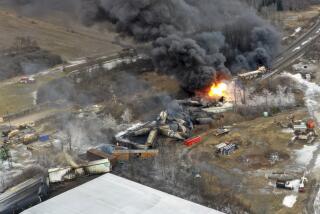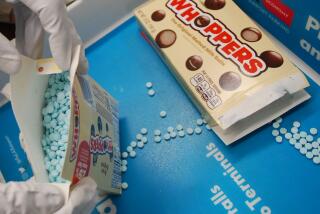PETN: The explosive that airport security is targeting
- Share via
Reporting from Washington — New airport security procedures that have stirred the emotions of air travelers — full-body scans and aggressive pat-downs — were largely designed to detect an explosive powder called PETN, which has been a staple of Al Qaeda bomb makers for nearly a decade.
It was PETN that was molded into the sole of Richard Reid’s black high-top sneaker when he walked onto American Airlines Flight 63 bound for Miami in December 2001.
It was PETN that was sewn into the underwear of Umar Farouk Abdulmutallab, authorities say, when he boarded Northwest Airlines Flight 253 for Detroit on Christmas Day 2009.
And it was PETN that suspected Al Qaeda operatives in Yemen packed inside computer printer cartridges that were shipped Oct. 28, intending to blow up planes en route to Chicago.
None of the plots succeeded in taking down an aircraft, but top U.S. officials are concerned about fresh indications that Al Qaeda remains determined to get PETN on airplanes by trying to exploit vulnerabilities in passenger and cargo screening.
Not only has the terrorist network acknowledged its role in bomb plots, it is also sharing what it knows about building bombs on the Web and elsewhere.
PETN, or pentaerythritol tetranitrate, presents some vexing problems for security experts. A powder about the consistency of fine popcorn salt, it will not trigger an alarm on a metal detector. Because of its more stable molecules, PETN gives off less vapor, making it more difficult to detect by bomb-sniffing dogs and the trace swabs used by the Transportation Security Administration.
PETN’s stability makes it easy to hide and easily transformed. When mixed with rubber cement or putty, it becomes a rudimentary plastic explosive — a baseball-sized amount can blow a hole in an airplane fuselage.
“PETN is hard to detect and lends itself to being concealed,” said an intelligence official who was not authorized to speak on the record. “It packs a punch.”
One way to detect PETN is through its detonator, which typically uses materials that are easier to trace. Reid’s shoe bomb combined PETN with a volatile explosive accelerant called TATP that can be made from dime-store nail polish and hydrogen peroxide. The Yemen printer cartridge bombs placed the PETN around small homemade blasting caps containing the chemical lead azide.
The fact that PETN has been the common denominator in all of the bombs is a major reason why the TSA is unlikely to yield substantially in its search for practical ways to prevent the deadly powder from making it aboard a plane.
The new aggressive pat-downs and the increased use of full-body scanners — there are more than 400 machines in 69 U.S. airports — were a direct response to last year’s alleged bombing attempt on Christmas Day, when Abdulmutallab passed through screening with 80 grams of PETN, authorities say.
Some passengers have objected to the enhanced screening as an invasion of privacy, though several polls show air travelers consider safety far more important.
“I know people want to bomb us,” TSA chief John Pistole told reporters Monday. Pistole isn’t just worried about terrorists in Yemen. He said he is particularly concerned that home-grown terrorists might “get ahold of a PETN device.”
PETN can be made in a rudimentary lab or salvaged from old munitions. It can scraped from old bombs or stripped out of detonator cord, a fast-burning fuse about the diameter of a clothesline that is commonly used in road construction and mining. The amount of PETN in 5 feet of detonator cord has enough explosive power to buckle the roof of a car.
Smuggling explosives onto airplanes is a vulnerability that the TSA has known about since 2005, when covert testing teams run by the Department of Homeland Security inspector general were able to penetrate TSA airport security with explosive-like test devices, Pistole said.
The best technological weapons that the TSA has now are body scans of passengers and X-rays of cargo and baggage. But the scanners can’t see anything hidden inside body cavities, and their effectiveness relies on operators identifying something unusual.
The scanners are “just anomaly detectors. Someone has to notice, has to have some expertise,” said former Homeland Security Inspector General Clark Kent Ervin, who managed covert testing teams in 2003 and 2004 that were able to get guns, knives and explosives through TSA screening.
There are new techniques available for cargo, baggage and passenger screening that can detect individual explosive molecules using mass spectrometry, a technology that would be better at identifying PETN than the swab machines in use by the TSA.
“There is no question that the technology now deployed can’t do it,” Ervin said.
Even technology can only detect so much. The printer cartridge bombs from Yemen were sealed in plastic and cleaned with solvents to remove PETN molecules. The packages were discovered because of a tip from Saudi intelligence services.
Frank Cilluffo, director of the Homeland Security Policy Institute at George Washington University, said security screening needed to be less predictable, “so Al Qaeda and our [other] adversaries can’t simply game the system.”
The TSA also should invest in better human intelligence and institute a method of questioning passengers that Israel uses at airport checkpoints, said Edward Luttwak, an expert on security strategy and a senior advisor at the Center for Strategic and International Studies.
In recent discussions with members of the security services in Israel, Luttwak found “general puzzlement about TSA’s enthusiasm for these machines.”
The TSA’s plan to spend hundreds of millions of dollars deploying more than 1,000 full-body scanners by the end of 2011 “is a syndrome of having no budget limits and maybe aggressive salesmanship,” Luttwak said.
Israeli screeners, he added, are not looking for people who fit a physical profile, but a behavioral profile of avoidance and inconsistency. In Luttwak’s view, it is easier for terrorists to design a bomb that can get past a screening regime than it is to find someone who is both a good actor and willing to be a suicide bomber.
A TSA program to identify suspicious behavior in search lines has deployed about 3,000 agents in more than 160 U.S. airports. Officers are trained to identify suspicious facial expressions and body language by walking up and down the line, initiating conversations and pulling passengers for additional screening.
In a glossy, color magazine released this week by Al Qaeda in the Arabian Peninsula, the Yemeni-based group vowed to continue using PETN. The magazine, written in English, included photos and a detailed description of how the printer cartridge bombs were made and packaged to avoid detection by bomb-sniffing dogs.
The authors encouraged copycat attacks: “Do you think that our research will only be used by Al Qaeda of the Arabian Peninsula and won’t be shared with other mujahidin?”
The headline on the magazine was simply “$4,200” — the amount the group says it spent to build and ship the bombs.
More to Read
Sign up for Essential California
The most important California stories and recommendations in your inbox every morning.
You may occasionally receive promotional content from the Los Angeles Times.











